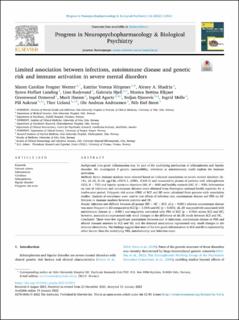Limited association between infections, autoimmune disease and genetic risk and immune activation in severe mental disorders
Werner, Maren Caroline Frogner; Wirgenes, Katrine Verena; Shadrin, Alexey; Lunding, Synve Hoffart; Rødevand, Linn; Hjell, Gabriela; Ormerod, Monica; Haram, Marit; Agartz, Ingrid; Djurovic, Srdjan; Melle, Ingrid; Aukrust, Pål; Ueland, Thor; Andreassen, Ole; Steen, Nils Eiel
Journal article, Peer reviewed
Published version

Åpne
Permanent lenke
https://hdl.handle.net/11250/3009975Utgivelsesdato
2022Metadata
Vis full innførselSamlinger
- Department of Clinical Science [2289]
- Registrations from Cristin [9462]
Originalversjon
Progress in Neuro-psychopharmacology and Biological Psychiatry. 2022, 116, 110511. 10.1016/j.pnpbp.2022.110511Sammendrag
Background
Low-grade inflammation may be part of the underlying mechanism of schizophrenia and bipolar disorder. We investigated if genetic susceptibility, infections or autoimmunity could explain the immune activation.
Methods
Seven immune markers were selected based on indicated associations to severe mental disorders (IL-1Ra, sIL-2R, IL-18, sgp130, sTNFR-1, APRIL, ICAM-1) and measured in plasma of patients with schizophrenia (SCZ, N = 732) and bipolar spectrum disorders (BD, N = 460) and healthy controls (HC, N = 938). Information on rate of infections and autoimmune diseases were obtained from Norwegian national health registries for a twelve-year period. Polygenic risk scores (PRS) of SCZ and BD were calculated from genome-wide association studies. Analysis of covariance were used to test effects of infection rate, autoimmune disease and PRS on differences in immune markers between patients and HC.
Results
Infection rate differed between all groups (BD > HC > SCZ, all p < 0.001) whereas autoimmune disease was more frequent in BD compared to SCZ (p = 0.004) and HC (p = 0.003). sIL-2R was positively associated with autoimmune disease (p = 0.001) and negatively associated with PRS of SCZ (p = 0.006) across SCZ and HC; however, associations represented only small changes in the difference of sIL-2R levels between SCZ and HC.
Conclusion
There were few significant associations between rate of infections, autoimmune disease or PRS and altered immune markers in SCZ and BD, and the detected associations represented only small changes in the immune aberrations. The findings suggest that most of the low-grade inflammation in SCZ and BD is explained by other factors than the underlying PRS, autoimmunity and infection rates.
